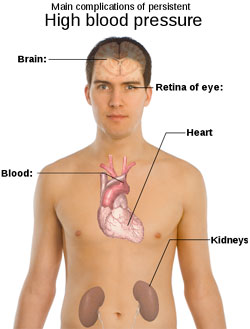 The primitive stress response, instigated by the action of the sympathetic part of the autonomic nervous system, prepares the heart and the blood vessels for action. It accelerates heart rate, constricts the blood supply to inessential parts and increases it to the heart muscles and limbs while the spleen contracts to top up the blood supply from its reserves. The autonomic nervous system also dries the mouth, stills the guts, increases sweating and mobilizes sugars and fats so that there is plenty of energy available to fight or flee. To some extent, the parasympathetic effect of the autonomic nervous system acts in a contrary way. It conserves energy, aids digestion and takes some of the load off the heart.
The primitive stress response, instigated by the action of the sympathetic part of the autonomic nervous system, prepares the heart and the blood vessels for action. It accelerates heart rate, constricts the blood supply to inessential parts and increases it to the heart muscles and limbs while the spleen contracts to top up the blood supply from its reserves. The autonomic nervous system also dries the mouth, stills the guts, increases sweating and mobilizes sugars and fats so that there is plenty of energy available to fight or flee. To some extent, the parasympathetic effect of the autonomic nervous system acts in a contrary way. It conserves energy, aids digestion and takes some of the load off the heart.
Just as the cardiovascular system was the target for the flight or fight response in primitive man, it is the target for today’s stresses and strains. Some of the first physical signs of the over-stressed person are apparent in the arteries. Patients are too easily pleased with the state of their arteries; provided that the blood is flowing through them, they rest assured that their absurd lifestyle has not damaged them. However, modern science, in the form of an External Beam CT scan (EBCT), can measure the amount of calcium and fat-laden deposits, or atheromas, collecting in the wall of the artery, which in time will ooze into the arterial lumen.
At first, these lumps will adhere to the inside of the arterial wall; later they may either grow across the artery and progressively obstruct it – thereby denying oxygen and other nutrients to the heart muscle, and causing angina once the patient exercises. Conversely, the lump may rupture and its fatty contents may escape into the circulation in clots known as thrombi. If a thrombus blocks one of the coronary arteries, the patient suffers what is known as coronary thrombosis or myocardial infarction: the destruction of an area of heart muscle once its blood supply is obstructed. A myocardial infarction, or MI, is a sudden heart attack that all too often is fatal.
Stress and High Blood Pressure
Even as the arteries are narrowing or becoming clogged by an atheroma which has formed as a result of the metabolic disturbances set in motion by stress, a life that is constantly full of tension causes hardening and constriction of those same arteries, resulting in a rise in the blood pressure. High blood pressure – known, appropriately, as hypertension -may lead to strokes, heart attacks and sometimes kidney failure or even retinal damage to the eyes. High blood pressure is another consequence of a stressed life.
Stress and Strokes
A stroke is any condition which, by interfering with the blood supply to the different parts of the brain, causes paralysis or some evidence of upset of the brain’s normal function. There are two main types of stroke. The most common form is known as the ischaemic stroke. In the ischaemic stroke, the lumen of the cerebral blood vessel is blocked by a thrombus so that a cerebral infarction (death of part of that part of the brain supplied by the artery) follows.
A transitory stroke, which is one in which the symptoms last less than a day, is known as a transient ischaemic attack, or TIA. In this case, the blood vessel wasn’t blocked by a thrombus that became lodged, but by a clot that passed on. Under a quarter of strokes are not caused by thrombi blocking an artery but by a haemorrhage (bleed) from a cerebral vessel that has ruptured; thus high blood pressure followed by a stroke is a frequent sequel to a lifetime of stress.
Stress and Aortic Aneurysm
One cardiovascular disease that is too often overlooked is the aortic aneurysm, which is frequently the result of stress, high blood pressure and above all, smoking. The aorta is the main blood vessel that leads from the heart – like the principal motorway leading from a capital city. If the blood pressure is raised, the walls of the aorta are subjected to increased pressure, and in all probability, they will have already been weakened by atherosclerosis.
Rupture of the aorta is one of the most alarming of emergencies. Patients are always fortunate to survive. People who have had high blood pressure for a long time, or have a family history of aortic aneurysms, especially if they have ever smoked, should have their aortas checked by ultrasound examination at regular intervals. If the first signs of the dilatation of the aorta can be detected early once the aneurysm is large enough, the damaged patch – which may look rather like the weak patch on a bicycle inner tube – can be replaced with an artificial graft.
